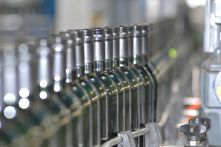
Stability

Packaging of wine: target of minimum risk!
With fast and reliable analytical solutions for preparation and monitoring of bottling, ICV Group laboratories support you in your risk management process:
- analyses before bottling, to assess appropriate treatment
- tartaric and protein stability analyses
- monitoring of bottling parameters: CO 2, SO 2, dissolved oxygen, fouling index, filterability coefficient, turbidity ...
- analytical monitoring by batch, pre and post bottling, to ensure saleability of the product
The stability analysis: pre and post bottling solutions
Stability analyses can eliminate the risk of precipitation or clouding, and to prepare the wines before filtration.
The use of analytical options of conditioning minimises irreversible accidents, at little cost.
The evaluation of the risk of tartaric precipitation:
The presence of tartrate crystals in a bottled wine is often misinterpreted by consumers. To ensure tartaric stability of your wines, we offer different reliable techniques for assessing risk.
The ICV solutions to prevent protein breakdown, without distorting the wines:
. a heat test, validated by teams in the research & development department.
. reasoned fining: severe enough not to underestimate the risk but reasonable enough to avoid overfining that has negative impact on the organoleptic quality of wines.
The analysis of iron and copper components:
This is a preventive action against the risk of breakage, but also to check the conformity of wines with European regulations before bottling.
In effect regulations limit the copper content of the wine to 1 mg / l and an iron content of less than 10mg / l is highly recommended.
It is also necessary to check the limits of certain metals that can damage human health.
Filterability coefficient (CF):
Evaluates the filterability of a wine to better manage the filtration stages:
. facilitates the choice of which filtration stages to set up, the decision whether or not to add an additional preparation stage
. improves the efficacity of stages in filtration
. optimises time and costs by reducing the risk of clogging
Key features:
. test carried out with a membrane having a porosity adapted to the turbidity of the wine
. monitoring of filtered wine coming in at under 1 bar at each weighing (1 point every 10 seconds for 2 minutes)
. conversion of data into the index: CF
. evaluation of the filterability of a wine on a media of porosity equivalent to that of the membrane used: 3 grades
. volume Required: a 75cl bottle
Benefits:
. more discriminating than the clogging index because it can also be achieved in turbid wines (<50NTU), that are not necessarily "ready" for the bottling.
. automated measurement and calculations
. answer as fast as for the IC: one day
. production of a specific report with a first level of conclusion on the filterability of the wines (best, average, bad and not feasible)
. oenologically relevant advice on the filtration type to use: consideration of density, turbidity and the membrane used.
Measuring dissolved oxygen
Performed in the laboratory on packaged bottle, measurement of dissolved O 2 can meet the requirements of your marketing company.
Expressed in mg / l with a error margin of 0.1 mg / l.
Parameter list
| Parameter | Method | Completion deadline |
|---|---|---|
|
Bentotest |
Test | 1 day |
|
Calcium |
atomic absorption spectrometry | 1 day |
|
CO2 |
FTIR / Corning / Orbisphère | 1 day |
|
Collage |
2 days | |
|
Ferro Collage |
2 days | |
|
Conductivity |
conductimetry | 1 day |
|
Copper |
atomic absorption spectrometry | 1 day |
|
Tasting |
2 days | |
|
Nutrition labeling * |
8 to 10 days | |
|
Iron |
atomic absorption spectrometry / colorimetry sequential method | 1 day |
|
Filtration |
1 day | |
|
ISTC 50 |
conductimetry (Stabilab) | 1 to 2 days |
| Clogging Index | Filtration | 1 day |
|
CF: Coefficient Filterability |
Filtration | 1 day |
|
STI: tartaric stability index |
ISTmètre | 1 to 2 days |
|
Minicontact |
Stabisat | 1 day |
|
Dissolved oxygen |
luminescence | 1 day |
|
Potassium |
FTIR / atomic emission spectrometry | 1 day |
|
Search ferro |
2 days | |
|
Active SO2 |
calculation | ½ to 1 days |
| Free SO2 | continuous flow / sequential colour Frantz Paul / iodometry | ½ to 1 days |
| Total SO2 | continuous flow / sequential colour Frantz Paul / iodometry | ½ to 1 days |
|
DIT: Degree of Tartaric Instability |
conductimetry (Stabilab) | 1 to 2 days |
|
Overpressure |
Aphrométrie | 1 day |
|
Test pinking |
1 day | |
|
Test proteins |
Turbidity before / after heating | 1 day |
|
Treatment for ferrocyanide |
2 days | |
|
Tsat |
stabisat | 1 to 2 days |
|
Turbidity |
turbidimetrically | 1 day |
|
Caloric value |
calculation | 1 day |
|
Vmax |
filtration | 1 day |
* Analysis outsourced
Non exhaustive list
Download
-

Plaquette analyses de stabilité -
1.36 MB
-

Plaquette coefficient de filtrabilité -
217.68 KB
